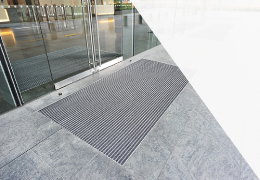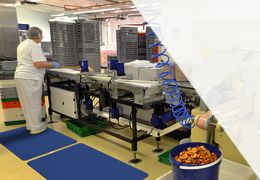Polyester, cotton, aramid, silk, linen, viscose - these materials all belong to the same family: fibers. Invisible to the naked eye, fibers can be hazardous to your health if you are overexposed and fail to protect yourself. Indeed, they have long been a problem in the building and civil engineering sector, but not the only one. Since the asbestos health crisis, numerous measures relating to the use of fibers have been put in place to ensure the safety of professionals and private individuals alike.
Why and how do fibers affect our health? How can we prevent this risk and protect ourselves? NeoSol, the flooring expert, provides some answers in this new article.
Why are fibers dangerous?
Before explaining the various characteristics and health hazards of this material, it's important to understand what is meant by the word fiber. Fibers are considered a chemical agent. It's an elongated particle whose length is 3 times its diameter. The finer it is, the more dangerous it is to health.
There are many different types of fiber, which can be classified into 3 main groups: synthetic, artificial and natural.
- Synthetic fiber
o Organic: polyester, aramid, etc.
o Inorganic: carbon fiber, glass fiber...
- Artificial fiber
o Organic: viscose, cellulose acetate...
- Natural fiber
o Organic: cotton, linen...
o Inorganic: asbestos, sepiolite, wollastonite...
These fibers are used in a wide range of industries and applications. For example, glass wool is used as insulation, polyester for floor coverings, cotton or silk for clothing or paper, and so on.
It's important to understand that organic fibers have no impact on health and are not harmful. That's why they can be found on virtually all our professional floor mats: dirt-repellent mats, food-processing mats, gratings, etc.
Fiber: a hazardous material for professionals
Handling fiber without protection damages the respiratory system and can cause serious illness. The main entry point for fibers into the body is the nasal cavity. They then pass through the trachea, the pulmonary alveoli and finally the cells of the bronchi. The finer and longer they are, the more easily they propagate into the thoracic cavity and surrounding organs. Generally speaking, a healthy body naturally gets rid of fibers, but some form a deposit in the lungs when inhaled repeatedly.
Eventually, this triggers serious chronic diseases such as :
- asthma,
- chronic lung disease,
- inflammation of the mucous membranes of the lungs and nose,
- respiratory failure,
- damage to the pleura, which can disrupt cell division and cause chromosomal changes.
Not all fibers are toxic to the body. This is why they are classified according to their degree of danger, their composition and their size. Research has been carried out byINSERM (Institut national de la santé et de la recherche médicale) and IARC (Institut national de recherche sur le cancer) to better prevent and treat occupational diseases, and to introduce individual preventive measures such as PPE. Fiber inhalation is therefore considered an occupational hazard, ultimately leading to pulmonary and carcinogenic problems (see asbestos-related health crisis).
Measures to prevent fiber-related illnesses
Identification of the hazard, assessment of the risk to health and safety in the workplace, elimination of the risk, implementation of preventive measures, verification of the effectiveness of the measures, and employee training and information are the 6 stages of the prevention principle set out in the French Labor Code. These steps have made it possible to apply chemical risk prevention regulations (CT. article L.4121-2) on fibers. In fact, depending on the degree of danger posed by the fibers, the use of personal protective equipment such as masks or gowns is mandatory when handling them. Working with these materials in an open, ventilated space is strongly recommended to evacuate as many fibers as possible.
Employers and employees are also required to comply with the Occupational Exposure Limit (OEL). The purpose of this indicator is to limit the time workers are exposed to this particle. Medical follow-up is recommended for employees working with toxic fibers. Finally, there are other organizational and technical measures that can be put in place to prevent the risk of fiber-related occupational illnesses.
NEED ADVICE?
Contact Céline
![Fire classification, UPEC and ISO 10874 standards Fire classification, UPEC and ISO 10874 standards]() Fire classification, UPEC and ISO 10874 standardsFire rating and quality standards should be one of the main criteria to consider before buying professional flooring. Find out why with NEOSOL.Read More
Fire classification, UPEC and ISO 10874 standardsFire rating and quality standards should be one of the main criteria to consider before buying professional flooring. Find out why with NEOSOL.Read More![Static electricity risks and solutions Static electricity risks and solutions]() Static electricity risks and solutionsHow dangerous is static electricity for employees? How do industries reduce the risks associated with electrostatic discharge?Read More
Static electricity risks and solutionsHow dangerous is static electricity for employees? How do industries reduce the risks associated with electrostatic discharge?Read More![Professional mats: how to care for them? Professional mats: how to care for them?]() Professional mats: how to care for them?Professional mat maintenance is essential to maintain the longevity of your mat and the safety of passers-by. NEOSOL, the flooring expert, reveals its different maintenance methods.Read More
Professional mats: how to care for them?Professional mat maintenance is essential to maintain the longevity of your mat and the safety of passers-by. NEOSOL, the flooring expert, reveals its different maintenance methods.Read More![Accessibility and ERP: how do I know if I'm in compliance? Accessibility and ERP: how do I know if I'm in compliance?]() Accessibility and ERP: how do I know if I'm in compliance?Accessibility must be a priority for every ERP. But you still need to know if you're in compliance. To help you, NeoSol, the professional flooring specialist, tells you more.Read More
Accessibility and ERP: how do I know if I'm in compliance?Accessibility must be a priority for every ERP. But you still need to know if you're in compliance. To help you, NeoSol, the professional flooring specialist, tells you more.Read More














Leave a comment